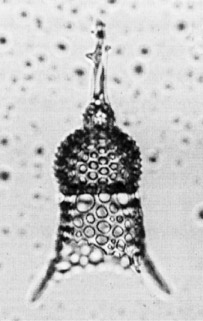 Lophocyrtis
(Lophocyrtis) jacchia (Ehrenberg)
Lophocyrtis
(Lophocyrtis) jacchia (Ehrenberg) Lophocyrtis
(Lophocyrtis) jacchia (Ehrenberg)
Lophocyrtis
(Lophocyrtis) jacchia (Ehrenberg)Thyrsocyrtis jacchia Ehrenberg, 1873, p.261; 1875, pl.12, fig.7
Lophocyrtis(?) jacchia (Ehrenberg), Riedel and Sanfilippo, 1970, p.530; Riedel and Sanfilippo, 1971, p.1594, pl.3C, figs.4-5, pl.7, fig.16; Sanfilippo, 1990, p.302, pl.I, figs.5-10, pl.III, fig.6
Three-segmented theoperid with a porous subspherical cephalis bearing a well-developed conical horn that is distally thorned and has arches at the base where it joins the cephalis. Cephalic wall perforated by 20-30 small circular to subcircular pores. Collar stricture marked by a distinct change in contour. Some specimens have a single row of larger pores just below the collar stricture. Thorax inflated hemispherical with a rough sometimes thorny surface, and 18-25 pores around the greatest circumference. Abdomen subcylindrical with three short subcylindrical, subterminal or terminal, strongly divergent feet. The abdominal pores are irregularly arranged, and vary in size from half to twice the size of the thoracic pores. Some specimens have a single row of larger pores just below the lumbar stricture, similar to the row of pores at the collar stricture (Sanfilippo, unpubl. data).
Total length (excluding horn and feet) 135-215 µm; length of thorax 45-80 µm, its maximum width 65-110 µm, number of pores around its circumference 18-25; length of abdomen 45-90 µm, its maximum width 75-100 µm and the number of pores around its circumference 12-20. (Sanfilippo, 1990).
The apical horn is supported by three (possibly four) arches. Abdomen subcylindrical, with undifferentiated termination; except in late specimens, there are three or four terminal or subterminal feet (Riedel and Sanfilippo, 1978a).
L. (L.) jacchia is distinguished from its descendant L. (L.) exitelus (Sanfilippo, 1990, p.300) by the greater number of pores around the abdominal circumference (usually 16-20 vs. 6-12) and from L. (Cyclampterium) hadra (Sanfilippo, 1990, p.304) by having a narrow, terminally open abdomen (Sanfilippo, 1990).
Middle-latitude forms range from typical low-latitude Lophocyrtis morphotypes of L. jacchia to what appear to be middle-latitude morphotypes. These forms have a slender conical horn with almost non-existent arches near the base, smaller abdominal pores (24-30 vs. 16-20 pores around the circumference) and the short feet commonly distort the cylindrical shape of the abdomen. High-latitude forms are quite similar with the exception of a more robust, thicker shell (modified from Sanfilippo, 1990).
This cosmopolitan species occurs from the late Paleocene Bekoma bidartensis Zone into the upper part of the Cryptocarpium ornatum Zone straddling the Eocene/Oligocene boundary. L. jacchia occurs rarely and sporadically in the early part of its range and becomes more consistent and moderately abundant later in its range.
The earliest occurrence of L. (L.) jacchia is in the late Paleocene, and its ancestry is not yet known. It persists with little morphologic change until the latest Eocene where it gives rise to the subgenus Cyclampterium and subsequently evolves into the short-lived L. (L.) exitelus.